OIL DEGUMMING PROCESS & MACHINERY
 Oil degumming and bleaching are the further two processes that are very important in the vegetable oil processing. Oil degumming is defined as the treatment of additives that are used for the removal of waxes, phosphates, and other impurities in vegetable oil. Some of these additives are salt solutions, crude oils & water, dilute acids, or alkalis. In case of Caustic Soda, also known as Sodium Hydroxide, and used for removing free fatty acids, can cause rancidity along with decreasing the quality of the edible oil. Some of the important points of this process are listed below:
Oil degumming and bleaching are the further two processes that are very important in the vegetable oil processing. Oil degumming is defined as the treatment of additives that are used for the removal of waxes, phosphates, and other impurities in vegetable oil. Some of these additives are salt solutions, crude oils & water, dilute acids, or alkalis. In case of Caustic Soda, also known as Sodium Hydroxide, and used for removing free fatty acids, can cause rancidity along with decreasing the quality of the edible oil. Some of the important points of this process are listed below:
- To form soaps and assists in the removal of toxic substances present in the plants, alkali solutions are combined with free fatty acids
- Here, the temperatures are around 75°C (167°F
- At this stage, the oil still shows the clear signs of pigmentation of yellow, red, or greenish hue, which is considered as undesirable
The process of degumming converts the phosphatides to the hydrated gums that are highly insoluble in oil and are quickly separated as the sludge. For the crude lecithin processing, all the hydrated gums are completely vacuum dried. In this process, phosphoric acid and water are added at the temperatures of 60°C (140°F). The industry' hypothesis for the degumming process is listed below:
- Removal of lecithin is essential that can cause rancidity of the oil
- It completely satisfies all the export oil needs for a product, which is free from impurities that settle out during the shipment
- Before the alkali refining, gum removal improves the yield, as the phosphates can act as emulsifiers in a caustic solution, thereby enhancing the neutral oil contained in the soapstock
- It largely decreases the refinery waste load due to the reduction of gums discharged and lower neutral oil losses
- It makes the oil ideal for steam refining. Degummed oil suits to this physical refining technique more mainly due to the significant reduction of various nonvolatile impurities like phosphatides and metallic prooxidants
- It ensures improved acidulation performance.
The next step in the oil purification is bleaching of the oils. This is important because the crude vegetable oils have a yellow or reddish pigment, which is highly undesirable. In this process, the oils are heated for around 4 hours to the temperatures of 175°-225°C. Then, the oils are mixed with a clay substance which absorbs all the undesired pigment. A large amount of clay used is properly filtered from the oil and we get the pure edible oil ready for the cooking and consumption.
